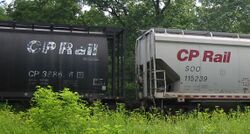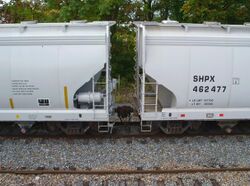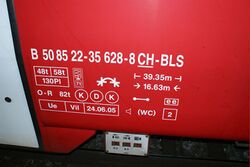Reporting mark
 From HandWiki - Reading time: 6 min
From HandWiki - Reading time: 6 min

A reporting mark is a code used to identify owners or lessees of rolling stock and other equipment used on certain rail transport networks. The code typically reflects the name or identifying number of the owner, lessee, or operator of the equipment.
In North America, the mark, which consists of an alphabetic code of two to four letters, is stenciled on each piece of equipment, along with a one- to six-digit number. This information is used to uniquely identify every such rail car or locomotive, thus allowing it to be tracked by the railroad it is traveling over, which shares the information with other railroads and customers.[1][2] In multinational registries, a code indicating the home country may also be included.
Standard practices
North America

The Association of American Railroads (AAR) assigns marks to all carriers, under authority granted by the U.S. Surface Transportation Board, Transport Canada, and Mexican Government. Railinc, a subsidiary of the AAR, maintains the active reporting marks for the North American rail industry.
Under current practice, the first letter must match the initial letter of the railroad name. As it also acts as a Standard Carrier Alpha Code, the reporting mark cannot conflict with codes in use by other nonrail carriers.[1][2]
Marks ending with the letter "X" are assigned to companies or individuals who own railcars, but are not operating railroads;[lower-alpha 1] for example, the TTX Company (formerly Trailer Train Company) is named for its original reporting mark of TTX. In another example, the reporting mark for state-funded Amtrak services in California is CDTX (whereas the usual Amtrak mark is AMTK) because the state transportation agency (Caltrans) owns the equipment used in these services. This may also apply to commuter rail, for example Metrolink in Southern California uses the reporting mark SCAX because the equipment is owned by the Southern California Regional Rail Authority—which owns the Metrolink system—even though it is operated by Amtrak. This is why the reporting mark for CSX Transportation, which is an operating railroad, is CSXT instead of CSX. Private (non-common carrier) freight car owners in Mexico were issued, up until around 1990, reporting marks ending in two X's, possibly to signify that their cars followed different regulations (such as bans on friction bearing trucks) than their American counterparts and so their viability for interchange service was impaired. This often resulted in five-letter reporting marks, an option not otherwise allowed by the AAR.
Companies owning trailers used in trailer-on-flatcar service are assigned marks ending with the letter "Z", and the National Motor Freight Traffic Association, which maintains the list of Standard Carrier Alpha Codes, assigns marks ending in "U" to owners of intermodal containers.[1][2] The standard ISO 6346 covers identifiers for intermodal containers.
When the owner of a reporting mark is taken over by another company, the old mark becomes the property of the new company. For example, when the Union Pacific Railroad (mark UP) acquired the Chicago and North Western Railway (mark CNW) in 1995, it retained the CNW mark rather than immediately repaint all acquired equipment. Some companies own several marks that are used to identify different classes of cars, such as boxcars or gondolas.[2] If the acquiring company discontinues the name or mark of the acquired company, the discontinued mark is referred to as a "fallen flag" railway. Occasionally, long-disused marks are suddenly revived by the companies which now own them. For example, in recent years, the Union Pacific Railroad has begun to use the mark CMO on newly built covered hoppers, gondolas and five-bay coal hoppers. CMO originally belonged to Chicago, St. Paul, Minneapolis and Omaha Railway, a predecessor of the CNW, from which the UP inherited it. Similarly, during the breakup of Conrail, the long-retired marks of the Pennsylvania Railroad (PRR) and New York Central Railroad (NYC) were temporarily brought back and applied to much of Conrail's fleet to signify which cars and locomotives were to go to CSX (all cars labeled NYC) and which to Norfolk Southern (all cars labeled PRR). Some of these cars still retain their temporary NYC marks.
List of North American reporting marks
Because of its size, this list has been split into subpages based on the first letter of the reporting mark:
Europe since 2006
A railway vehicle must be registered in the relevant state's National Vehicle Register (NVR), as part of which process it will be assigned a 12-digit European Vehicle Number (EVN). The EVN schema is essentially the same as that used by the earlier UIC numbering systems for tractive vehicles and wagons, except that it replaces the 2-digit vehicle owner's code (see § Europe 1964 to 2005) with a 2-digit code indicating the vehicle's register country. The registered keeper of a vehicle is now indicated by a separate Vehicle Keeper Marking (VKM), usually the name of the owning company or an abbreviation thereof, which must be registered with the Intergovernmental Organisation for International Carriage by Rail (OTIF) and the European Union Agency for Railways (ERA)[3] and which is unique throughout Europe and parts of Asia and Northern Africa.
The VKM must be between two and five letters in length[lower-alpha 2] and can use any of the 26 letters of the Latin alphabet. Diacritical marks may also be used, but they are ignored in data processing (for example, Ö is treated as though it is O).[4]
The VKM is preceded by the code for the country (according to the alphabetical coding system described in Appendix 4 to the 1949 convention and Article 45(4) of the 1968 convention on road traffic), where the vehicle is registered and a hyphen. Some examples:
| Code | Country | Keeper |
|---|---|---|
| A-ÖBB | Austria | Österreichische Bundesbahnen |
| B-B | Belgium | Société Nationale des Chemins de fer Belges |
| CH-SBB | Switzerland (Switzerland) | Schweizer Bundesbahnen |
| D-DB | Germany (Germany) | Deutsche Bahn AG |
| F-SNCF | France | Société nationale des chemins de fer français |
| I-FS | Italy | Ferrovie dello Stato Italiane |
| L-CFL | Luxembourg | Société Nationale des Chemins de Fer Luxembourgeois |
| NL-NS | Netherlands | Nederlandse Spoorwegen |
| TR-TCDD | Turkey | Türkiye Cumhuriyeti Devlet Demiryolları |
When a vehicle is sold it will not normally be transferred to another register. The Czech railways bought large numbers of coaches from ÖBB. The number remained the same but the VKM changed from A-ÖBB to A-ČD.[citation needed]
Europe 1964 to 2005
The UIC introduced a uniform numbering system for their members based on a 12-digit number, largely known as UIC number. The third and fourth digit of the number indicated the owner, or more precisely the keeper of the vehicle. Thus each UIC member got a two-digit owner code. With the introduction of national vehicle registers this code became a country code. Some vehicles had to be renumbered as a consequence. The Swiss company BLS Lötschbergbahn had the owner code 63. When their vehicles were registered, they got numbers with the country code 85 for Switzerland and the VKM BLS. Example for an "Einheitswagen" delivered in 1957:
- delivered as BLS B 831
- renumbered with UIC number 50 63 20-33 801-5
- rebuilt 1991 and renumbered 50 63 20-33 705-4
- registered as 50 85 20-35 451-7 CH-BLS
United Kingdom
In the United Kingdom, prior to nationalisation, wagons owned by the major railways were marked with codes of two to four letters, these codes normally being the initials of the railway concerned; for example, wagons of the Great Western Railway were marked "G W"; those of the London, Midland and Scottish Railway were marked "L M S", etc. The codes were agreed between the railways and registered with the Railway Clearing House.
India
In India, wagons owned by the Indian Railways are marked with codes of two to four letters, these codes normally being the initials of the railway divisions concerned along with the Hindi abbreviation; for example, trains of the Western Railway zone are marked "WR" and "प रे"; those of the Central Railway zone are marked "CR" and "मध्य", etc. The codes are agreed between the railways and registered with the Ministry of Railways, Government of India.
| Railway Zone | Code | Zone Headquarters | |
|---|---|---|---|
| 1. | Northern Railway | NR | Delhi |
| 2. | North Eastern Railway | NER | Gorakhpur |
| 3. | Northeast Frontier Railway | NFR | Guwahati |
| 4. | Eastern Railway | ER | Kolkata |
| 5. | South Eastern Railway | SER | Kolkata |
| 6. | South Central Railway | SCR | Secunderabad (Hyderabad) |
| 7. | Southern Railway | SR | Chennai |
| 8. | Central Railway | CR | Mumbai |
| 9. | Western Railway | WR | Mumbai |
| 10. | South Western Railway | SWR | Hubballi |
| 11. | North Western Railway | NWR | Jaipur |
| 12. | West Central Railway | WCR | Jabalpur |
| 13. | North Central Railway | NCR | Allahabad |
| 14. | South East Central Railway | SECR | Bilaspur |
| 15. | East Coast Railway | ECoR | Bhubaneswar |
| 16. | East Central Railway | ECR | Hajipur |
| 17. | Kolkata Metro | MR | Kolkata |
| 18. | South Coast Railway | SCoR | Visakhapatnam |
See also
- Automatic equipment identification
- UIC Country Code, a series of prefixes used on rolling stock identification numbers by members of the International Union of Railways (UIC) to identify the country of origin of railway rolling stock
- UIC wagon numbers
Notes
- ↑ "X" originally meant "express", as the first non-railroad car owners were express companies such as Adams Express.
- ↑ There is a specific exemption to the length requirement for Belgian operator NMBS/SNCB, allowing them to use as a VKM their corporate logo of a single letter B enclosed within a circle.
References
- ↑ 1.0 1.1 1.2 "Mark Register". Railinc. https://www.railinc.com/rportal/mark-register.
- ↑ 2.0 2.1 2.2 2.3 McGonigal, Robert S. (May 1, 2006). "Understanding railroad reporting marks". Trains. http://trn.trains.com/railroads/abcs-of-railroading/2006/05/understanding-railroad-reporting-marks. Retrieved 2014-12-09.
- ↑ "ERA site where the monthly updated VKM list can be retrieved". http://www.era.europa.eu/document-register/pages/list-vkm.aspx.
- ↑ 2012/757/: Commission Decision of 14 November 2012 concerning the technical specification for interoperability relating to the operation and traffic management subsystem of the rail system in the European Union and amending Decision 2007/756/EC (notified under document C(2012) 8075)
External links
- Reporting Marks 1920-present – unofficial and incomplete compilation of historic reporting marks
 |
 KSF
KSF


